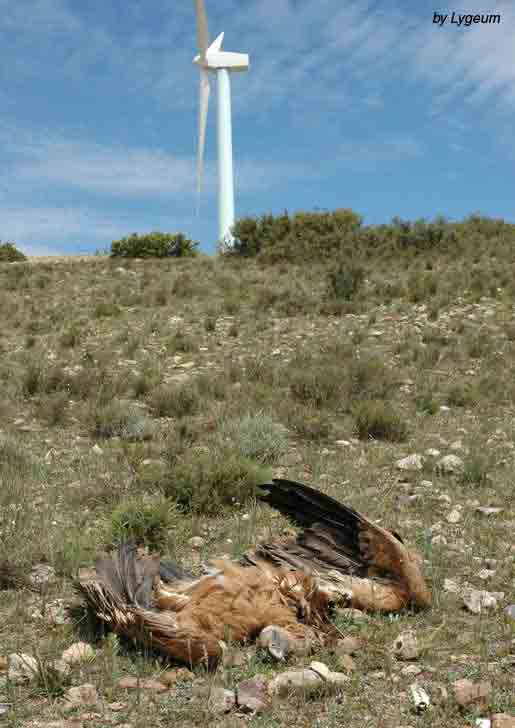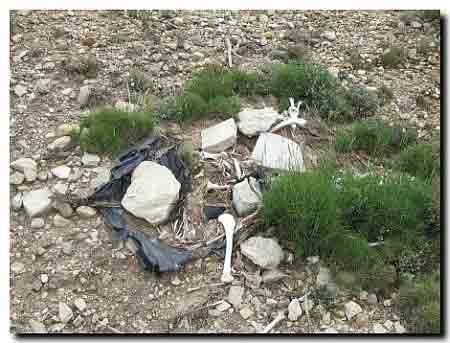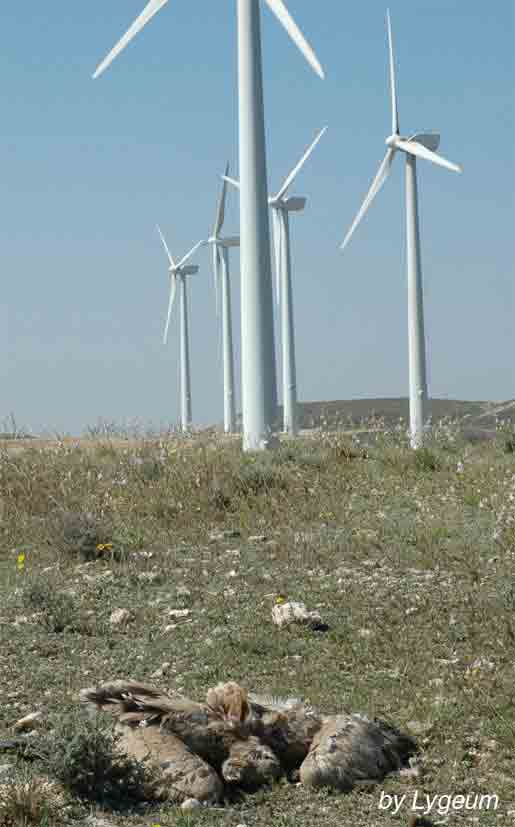| Windfarms slaughter vultures in Spain - Covering up the evidence. |
(2968) |
| REMAINS OF VULTURES FOUND IN PARTLY-UNEARTHED PLASTIC BAG. |
Overall vulture mortality at Spanish wind farms is well in excess of 1,000 griffon vultures per year, and probably closer to 2,000. Carcasses in a plastic bag have been buried at a wind farm site. They were later unearthed by scavengers, and found by ornithologists. Spanish Birdlife confirms that windfarm employees are hiding bird mortality evidence.
|

Photo:griffon vulture victim of wind turbine Nº 63. courtesy of El Sekano.
Please notify links that may no longer work to: save.the.eagles@gmail.com
VULTURE MORTALITY AT SPANISH WIND FARMS
- in a study commissioned by the government of Navarre, Dr Lekuona has estimated that about one third of Navarre´s windmills had killed 409 griffon vultures in one year ---> Birds and windfarms - Critical analysis of 4 reports on bird mortality at windfarm sites.
- In 2004, the Navarrian ecological association GURELUR advised me of a carnage at the new Caparroso wind farm in Navarre: over 200 vultures had been killed in the months following the inauguration. The news was later published in Gurelur magazine Nº16, Spring 2004, p.25.
- In northern Soria, a study estimated that the wind farms being monitored had killed about 200 griffon vultures in a year period. (Quercus magazine - Feb 2007).
- In 2008, the press related a carnage of griffon vultures by new wind farms in Castellón province : 177 kills in one and a half years. This prompted the government to: 1) shut the turbines down for a while ( to appease public opinion ) 2) erect more of them in the same region (sic) ---> LINK
- original text in Spanish : "en el decenio transcurrido entre 1993 y 2003, 151 aves acabaron descuartizadas en dos parques eólicos de Tarifa. De ellas, 111 eran buitres leonados".
Translation : in the decade from 1993 to 2003, 151 dead birds were found in 2 wind farms in Tarifa (near Gibraltar). Of them 111 were griffon vultures. Note : these 111 and the 177 above are not estimates, but raw data, i.e. actual carcasses found. The actual mortality is generally substantially higher than the number of carcasses found : several times more - see Lekuona study (1).
LINK to Lekuona study
The above figures are severely under-reported, for in one year alone, at only 2 wind farms in Tarifa, a study in 1995 found 82 carcasses including those of 30 griffon vultures :
Informe SEO/Birdlife sobre mortandad de aves en Tarifa - junio de 1995.
- I also received odd accounts of vultures killed in Cataluña, in Albacete, etc.
Considering these figures, it is likely that the overall mortality for Spain is well in excess of 1,000 griffon vultures yearly, and probably closer to 2,000.
Two blogs relate macabre findings on windfarm grounds in the State of Aragon, Spain. The first one, "el Sekano", is owned by an ornithologist who has done monitoring work at wind farms: Federico Faci. The second, "Barracuda", is run by a teacher who is also a naturalist: José Antonio Domínguez.
Quote (translated from Spanish) :
"SLAUGHTER AT PEDROLA III, May 15, 2006
LINK
Later visits made with Barracuda to windfarms in the Pedrola area have continued to evidence a high mortality of Griffon vultures (Gyps Fulvus). In an alignment of 11 turbines in the extension of a windfarm in La Serreta, 19 dead vultures were found. However, the most macabre find was that of the partially-buried remains of at least 2 vultures, in a plastic bag. All of this was reported to the environmental authorities, but it is still not known who hid the vultures in that windfarm."
Unquote

above picture : partially-buried remains of at least 2 vultures, in a plastic bag. Courtesy of El Sekano: LINK
And we find this relation in the other blog, BARRACUDA:
LINK
Quote (translated from Spanish) :
"SLAUGHTERHOUSE 19 (EOLICAZO III), May 14, 2006
Last week "el Sekano" and "Barracuda" found 19 dead griffon vultures under the 11 wind turbines that seem to correspond to the so-called "Serreta extension" in the municipality of Rueda de Jalón (province of Zaragoza, Spain). They would belong, therefore, to the Molinos del Ebro company, of the SAMCA group that is owned by the Luengo family, which has various windfarms in the area and is very much involved in the exploitation of mines in the region of Teruel.
The carcasses were not in the same state of decomposition. Some were very recent - a few days - and others had been there for several months. The facts were brought to the knowledge of the Department of the Environment of the Aragon government and a request was made to bring immediately the windfarm to a permanent halt, and to put a moratorium on the further installation of windfarms in Aragon. This onslaught against biodiversity, and this slaughter, cannot be permitted. We shall keep informing.
PHOTO Griffon vulture, victim of machine Nº 58
According to recorded data, the Extension of the La Serreta windfarm was authorized March 6th, 2001 and has 38 machines with a total capacity of 25.1 MW; all of which was added to the original windfarm of 24.4 MW which was authorized march 30th 1999."
Unquote
Here is now the literal translation from the post appearing here:
LINK
Quote :
"WHY DO WIND TURBINES KILL? - May 19, 2006
The reasons for which wind turbines take down bats and birds, and for which the blades hit them do not seem to be clear. I will outline here a possible cause, which is the high speed at the tip of the blades, which can act as knives.
I calculate below the linear speed of the blade tips of some modern wind turbines recently put up in Belchite (province of Zaragoza) and whose details are published in the magazine Noticias del Viento (Wind News), Nº 14, edited by the Asociación de Promotores de Energía Eólica de Aragón (Wind Energy Association of Aragon).
Data:
Belchite windfarm
Model: Vestas V82
Unit Capacity: 1650kW
Diameter: 82m (R = 41m each blade)
Speed (n): 14,4 rpm
I apply this formula: v = 2 pi R n 60/ 1000 = 222,6 km/h
I estimate that this speed may be deemed very high, and the flying animals find themselves unable to foresee it and to take it into consideration. Since many birds die on our roads, killed by automobiles whose speeds are around 100 km/h, and which they are unable to avoid, if we double the speed it is not surprising that vultures, swifts and larks would die, hacked by the arms of the turbines.
At any rate, mortality data on flying vertebrates show that it is very high, and that it is constant, which would indicate a permanent onslaught against biodiversity and clearly shows that the wind energy being installed is very aggressive an unsustainable, which means that alternatives have to be found.

Foto: carcass of a griffon vulture in the Pedrola windfarm (province of Zaragoza, Aragon).
However, since mortality in Aragon is actually occurring with wind turbines of less capacity, which are mainly 660Kw, I include below the linear speed at the tip of the blades calculated for this type of machines in accordance with data provided by their manufacturers.
Company: MADE-ENDESA
Wind turbine MADE AE46/I 660kW
Diameter: 46m
Revolutions: 17 to 25.5 rpm
Speed = 147 a 221 km/h
Wind turbine MADE AE52 800kW
Diameter: 52m
Revolutions: 12.8 to 25.71 rpm
Speed = 125 to 252 km/h
Wind turbine MADE AE61 1300kW
Diameter: 61m
Revolutions: 12.5 to 18.8 rpm
Speed = 144 to 216km/h
It may be observed today in Aragon that the tendency is to use wind turbines of increasing generating capacity (there are projects with 2MW turbines). But if the rpms come down, the arms of these machines are longer, and the linear speed at the tip stay above 200 km/h."
Unquote
END OF TRANSLATION OF BLOG POSTS
CONCLUSION :
Standing alone, the annual death of 1,000 - 2,000 vultures might be sustainable in Spain, which has a population of c.20,000 pairs fledging on average 1+ chick per annum. But there are many other causes of death. For instance, many vultures die of starvation ever since the closure of feeding stations and the obligation for ranchers to bury cattle carcasses (since the mad cow epidemic). The illegal poisoning of carcasses of all kinds of dead animals in order to get rid of predators/scavengers is another important cause of vulture mortality. Another cause of death is electrocution on pylons or collision with transmission lines LINK. Thus, an annual wind turbine mortality of 1,000 - 2,000 individuals, coming on top of these other factors, is likely to cause the Spanish population of griffon vultures to decline year after year. It is already doing so with the rare, endangered Egyptian Vulture (Carrete et al., 2009).
Spain being the European stronghold of three species of vultures, it is easy to forsesee that this heavy windfarm mortality will condemn these (among other) emblematic birds to disappear altogether from the EU.
Another source of concern is the burying of carcasses, whose logical purpose is the concealing of bird mortality at wind farms. The findings related here date back to 2006. Since then, Spanish Birdlife wrote in their report of Dec. 2008: " It has been ascertained that bird carcasses have been hidden by wind farm workers, thinking perhaps that their jobs depend upon the birds that die in the wind farm. This reduces the mortality observed by searchers in monitoring programmes." (2)
This practice, which we have reasons to believe has spread world-wide, invalidates monitoring studies. Yet, such studies are being used to justify the erection of more wind farms in sensitive bird habitats and in migration corridors. We are thus headed towards a biodiversity disaster, aided and abetted by bird societies which fail to denounce these deceptive studies.
Mark Duchamp...........................24 May, 2006 (updated May 2010)
markduchamp@hotmail.com
FOOTNOTES :
(1) - Birds and windfarms - Critical analysis of 4 reports on bird mortality at windfarm sites.
(2) - B) - DIRECTRICES PARA LA EVALUACION DEL IMPACTO DE LOS PARQUES EOLICOS EN AVES Y MURCIELAGOS - SEO/Spanish Birdlife (Dec. 2008) : ---> LINK
" Se ha podido comprobar la ocultación de cadáveres por parte de trabajadores de los parques eólicos, tal vez pensando que su puesto de trabajo dependa de las aves que mueren en el parque, disminuyendo la tasa de mortalidad obtenida en los planes de vigilancia."
Translation : " It has been ascertained that bird carcasses have been hidden by wind farm workers, thinking perhaps that their jobs depend upon the birds that die in the wind farm. This reduces the mortality observed by searchers in monitoring programmes."
OTHER ARTICLES ON THE NEGATIVE EFFECTS OF WINDFARMS:
The negative effects of windfarms: links to papers published by Mark Duchamp
| Insertado
por: Mark Duchamp (24/05/2006) |
| Fuente/Autor:
Quoted text: José Antonio Domínguez and Federico Faci. Translation, introduction and conclusion: Mark Duchamp |

Valoración
Comentarios
|
